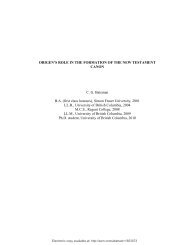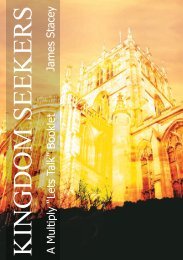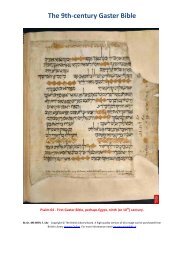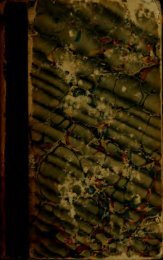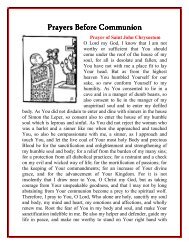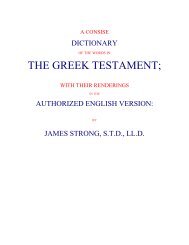'The Spiritual Exercises' of St. Ignatius Loyola
'The Spiritual Exercises' of St. Ignatius Loyola
'The Spiritual Exercises' of St. Ignatius Loyola
Create successful ePaper yourself
Turn your PDF publications into a flip-book with our unique Google optimized e-Paper software.
PREFACE<br />
THE present translation <strong>of</strong> the Exercises <strong>of</strong> <strong>St</strong>. <strong>Ignatius</strong> has been made<br />
from the Spanish Autograph <strong>of</strong> <strong>St</strong>. <strong>Ignatius</strong>. The copy so designated is not indeed<br />
in the handwriting <strong>of</strong> the Saint, but has a good number <strong>of</strong> corrections made by<br />
him and is known to have been used by him in giving the Exercises.<br />
<strong>St</strong>. <strong>Ignatius</strong> <strong>of</strong> <strong>Loyola</strong> was a man without any great pretensions to<br />
education at the time he wrote this book. His native language was not Spanish,<br />
but Basque. His lack <strong>of</strong> education and his imperfect acquaintance with pure<br />
Spanish are enough to make it clear that a refined use <strong>of</strong> any language, and more<br />
especially <strong>of</strong> the Spanish, or, in general, anything like a finished or even perfectly<br />
correct, style is not to be expected in his work. Literary defects he removed to some<br />
extent, perhaps, as he continued to use and apply the book, but he is known never<br />
to have been fearful <strong>of</strong> such faults. His corrections found in this text are clearly<br />
made with a view to precision more than to anything else.<br />
The Autograph <strong>of</strong> <strong>St</strong>. <strong>Ignatius</strong> was translated by Father General Roothaan<br />
into Latin and was reproduced by Father Rodeles in his edition <strong>of</strong> the Spanish<br />
text. But the original was not available to ordinary students. In 1908, however,<br />
Father General Wernz allowed the entire book to be phototyped, and in this way it<br />
was spread throughout the Society <strong>of</strong> Jesus in a large number <strong>of</strong> copies. It is one<br />
<strong>of</strong> these which has been chiefly employed by the present translator, who has,<br />
besides, made frequent use <strong>of</strong> the Manuscript itself.<br />
After considerable study <strong>of</strong> the matter, it seemed best to make this<br />
translation as faithful and close a reproduction <strong>of</strong> the Spanish text as could be. To<br />
do so it was necessary at times to sacrifice the niceties <strong>of</strong> style, but it was thought<br />
that those who would use the book would easily forego the elegancies <strong>of</strong> diction if<br />
they could feel sure they were reading the very words <strong>of</strong> <strong>St</strong>. <strong>Ignatius</strong>. Any other<br />
form <strong>of</strong> translation than the one adopted could hardly be kept from being a partial<br />
expansion, illustration or development <strong>of</strong> the original, and would therefore have<br />
proved, to some extent, a commentary as well as a translation. This the translator<br />
has earnestly sought to avoid, preferring to leave the further work <strong>of</strong> commentary<br />
to another occasion or to other hands.<br />
Another reason for aiming at absolute fidelity rather than style was the fact<br />
that the Exercises are mostly read, not continuously for any time, but piecemeal<br />
and meditatively. Literary finish would therefore not be much sought or cared for<br />
in the book, but accuracy is. For this a certain neglect <strong>of</strong> style seemed pardonable<br />
in the translation, if only the real meaning <strong>of</strong> the writer could be made clear.<br />
Perhaps some may even find a charm in the consequent want <strong>of</strong> finish, seeing it<br />
reproduces more completely the style <strong>of</strong> <strong>St</strong>. <strong>Ignatius</strong>.<br />
The process <strong>of</strong> translating in this way the Autograph text is not as simple<br />
as it might seem. The first difficulty is to make sure <strong>of</strong> the exact meaning <strong>of</strong> <strong>St</strong>.<br />
<strong>Ignatius</strong>. This is obscured, at times, by his language being that <strong>of</strong> nearly 400 years<br />
ago and being not pure Spanish. Occasionally, in fact, the Saint makes new<br />
Spanish words from the Latin or Italian, or uses Spanish words in an Italian or<br />
Latin sense, or employs phrases not current except in the Schools, and sometimes<br />
even has recourse to words in their Latin form. To be sure, then, <strong>of</strong> the meaning,<br />
one must <strong>of</strong>ten go to other languages and to the terms adopted in Scholastic<br />
Philosophy or Theology. The meaning clear, the further difficulty comes <strong>of</strong><br />
finding an exactly equivalent English word or phrase.<br />
In accomplishing his task, the translator has made free use <strong>of</strong> other<br />
translations, especially <strong>of</strong> that <strong>of</strong> Father General Roothaan into Latin, that <strong>of</strong>





